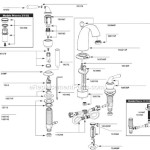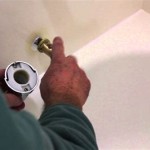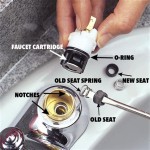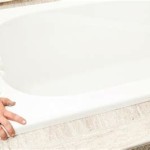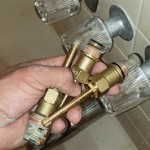How to Clean Bathtub Grips Effectively
Bathtub grips, those often-overlooked safety features, are prime real estate for the accumulation of soap scum, mildew, and general grime. Regular cleaning is essential not only for hygiene but also to maintain the grip's effectiveness, ensuring safety during showers and baths. Neglecting these grips can lead to significant build-up, making them difficult to clean and potentially compromising their functionality. This article provides a comprehensive guide on how to effectively clean bathtub grips, covering various cleaning methods and preventative measures.
Understanding the Challenge: Why Bathtub Grips Get Dirty
Bathtub grips are typically made of rubber, plastic, or textured surfaces designed to provide enhanced traction. This textured surface, while beneficial for safety, creates numerous crevices and pockets where dirt and grime can accumulate. The warm, moist environment of a bathroom fosters the growth of mold and mildew, further exacerbating the problem. Soap scum, a common byproduct of using soap and hard water, adheres stubbornly to the grip's surface. Over time, these factors combine to create a challenging cleaning situation.
The type of material the bathtub grip is made of also plays a crucial role in how quickly it becomes dirty and how difficult it is to clean. Rubber grips, for example, tend to be more porous and can absorb soap scum and mildew more readily than plastic grips. Textured surfaces, regardless of the material, create more surface area for dirt to cling to. Understanding these factors is the first step in selecting the appropriate cleaning method.
Another contributing factor is the frequency of use and ventilation in the bathroom. Bathrooms with poor ventilation trap moisture, creating a breeding ground for mold and mildew. Frequent use of the bathtub or shower leads to a faster accumulation of soap scum. Without regular cleaning, the build-up becomes increasingly difficult to remove, requiring more aggressive cleaning techniques.
Essential Supplies for Cleaning Bathtub Grips
Before commencing the cleaning process, it is essential to gather the necessary supplies. These supplies will vary depending on the chosen cleaning method, but some common items include:
- Cleaning cloths or sponges: Microfiber cloths are particularly effective for removing grime without damaging the grip's surface. Non-abrasive sponges are also suitable for general cleaning.
- Old toothbrush or scrub brush: These tools are essential for reaching into crevices and scrubbing away stubborn dirt.
- Spray bottle: Used for applying cleaning solutions.
- Baking soda: A natural and effective abrasive cleaner.
- White vinegar: An excellent solution for dissolving soap scum and killing mold and mildew.
- Dish soap: A mild detergent for general cleaning.
- Hydrogen peroxide: A disinfectant and stain remover.
- Bleach (optional): For heavily soiled areas, but use with caution and proper ventilation.
- Gloves: To protect hands from cleaning solutions.
- Safety glasses (optional): To protect eyes from splashes.
- Warm water: For rinsing and diluting cleaning solutions.
Having these supplies readily available will streamline the cleaning process and ensure that the job is completed effectively and efficiently. Always read the instructions on any cleaning product before use and test it on a small, inconspicuous area of the grip first to ensure it does not cause damage or discoloration.
Step-by-Step Cleaning Methods
Several cleaning methods can be employed to effectively clean bathtub grips. The choice of method will depend on the severity of the build-up and the type of material the grip is made of.
Method 1: Baking Soda and Vinegar Paste
This method is a natural and effective way to remove soap scum and mild mildew. Baking soda acts as a gentle abrasive, while vinegar helps dissolve the build-up.
- Mix baking soda and white vinegar in a small bowl to form a paste. The consistency should be thick enough to adhere to the grip's surface.
- Apply the paste liberally to the bathtub grips, ensuring that it covers all areas affected by soap scum and mildew.
- Allow the paste to sit for at least 15-20 minutes. This allows the baking soda and vinegar to penetrate and loosen the grime.
- Using an old toothbrush or scrub brush, scrub the grips thoroughly, paying particular attention to crevices and textured areas.
- Rinse the grips thoroughly with warm water to remove all traces of the paste.
- Dry the grips with a clean cloth.
If the stains are particularly stubborn, repeat the process or allow the paste to sit for a longer period. This method is generally safe for most types of bathtub grips, but it is always advisable to test it on a small area first.
Method 2: Dish Soap and Warm Water
For routine cleaning and maintenance, a simple solution of dish soap and warm water can be highly effective. This method is gentle and suitable for regular use.
- Mix a few drops of dish soap with warm water in a spray bottle.
- Spray the solution liberally onto the bathtub grips.
- Allow the solution to sit for a few minutes to loosen the dirt.
- Using a sponge or cleaning cloth, wipe down the grips thoroughly.
- For textured areas, use an old toothbrush or scrub brush to remove dirt from crevices.
- Rinse the grips thoroughly with warm water.
- Dry the grips with a clean cloth.
This method is ideal for preventing build-up and maintaining the cleanliness of bathtub grips on a regular basis. It is particularly effective for removing fresh soap scum and preventing the formation of mildew.
Method 3: Hydrogen Peroxide
Hydrogen peroxide is a mild disinfectant and stain remover that can be used to tackle more stubborn stains and mildew. It is a safer alternative to bleach and is effective at killing mold and bacteria.
- Pour hydrogen peroxide into a spray bottle.
- Spray the hydrogen peroxide liberally onto the bathtub grips, ensuring that it covers all affected areas.
- Allow the hydrogen peroxide to sit for at least 10-15 minutes.
- Using a sponge or cleaning cloth, wipe down the grips. For heavily stained areas, use an old toothbrush or scrub brush.
- Rinse the grips thoroughly with warm water.
- Dry the grips with a clean cloth.
Hydrogen peroxide can also be used in conjunction with baking soda for more stubborn stains. Simply make a paste of hydrogen peroxide and baking soda, apply it to the grips, and scrub after allowing it to sit for a while.
Method 4: Bleach Solution (Use with Caution)
Bleach is a powerful disinfectant and stain remover, but it should be used with caution due to its potential to damage surfaces and its strong fumes. Always ensure proper ventilation when using bleach.
- Dilute bleach with water in a ratio of 1:10 (one part bleach to ten parts water).
- Wear gloves and safety glasses to protect your skin and eyes.
- Apply the bleach solution to the bathtub grips using a sponge or cleaning cloth.
- Allow the solution to sit for no more than 5-10 minutes.
- Scrub the grips thoroughly with an old toothbrush or scrub brush.
- Rinse the grips extremely thoroughly with warm water to remove all traces of bleach.
- Dry the grips with a clean cloth.
Bleach should only be used as a last resort for heavily soiled areas and should be followed by thorough rinsing to prevent damage to the grip or the surrounding bathtub surface. Never mix bleach with other cleaning products, as this can create harmful fumes.
Preventative Measures to Keep Bathtub Grips Clean
Preventing build-up is just as important as cleaning. Implementing preventative measures can significantly reduce the frequency and intensity of cleaning required.
Rinse after each use: After each shower or bath, rinse the bathtub grips with clean water to remove soap scum and residue. This simple step can prevent the build-up from becoming stubborn.
Improve ventilation: Ensure adequate ventilation in the bathroom by opening windows or using the exhaust fan during and after showers or baths. This helps to reduce moisture levels and inhibit the growth of mold and mildew.
Regular cleaning schedule: Establish a regular cleaning schedule for the bathtub grips. Even a quick wipe-down with dish soap and water once a week can keep them clean and prevent build-up.
Use a squeegee: Use a squeegee to remove excess water from the bathtub and surrounding surfaces after each use. This helps to prevent water spots and soap scum from accumulating.
Consider alternative grip materials: When replacing bathtub grips, consider materials that are less prone to accumulating dirt, such as smooth plastic or grips with fewer textured surfaces.
By incorporating these preventative measures into the daily routine, it is possible to minimize the need for intensive cleaning and maintain the cleanliness and effectiveness of bathtub grips over the long term.

How To Clean A Non Slip Bathtub Decoist

Cleaning The Permanent Slip Guard Dots In My Porcelain Bathtub Hometalk

Mary Hunt Here S How To Clean A Bathtub Anti Slip Bottom Homes Lifestyle Noozhawk

How To Clean A Non Slip Bathtub Decoist

How To Clean A Bathtub The Right Way In 9 Easy Steps

This Tip Takes The Pain Out Of Cleaning Your Bathtub

This Tip Takes The Pain Out Of Cleaning Your Bathtub

How To Clean A Bathtub Anti Slip Bottom Everyday Skate

How To Clean A Bathtub Anti Slip Bottom Everyday Skate

Gorilla Grip Patented Shower Stall Mat 21x21 Machine Washable Square Bathroom Bath Tub Mats For Stand Up Showers And Small Bathtubs Drain Holes Keep Floor Clean Suction Cups Gray Opaque Com
Related Posts

